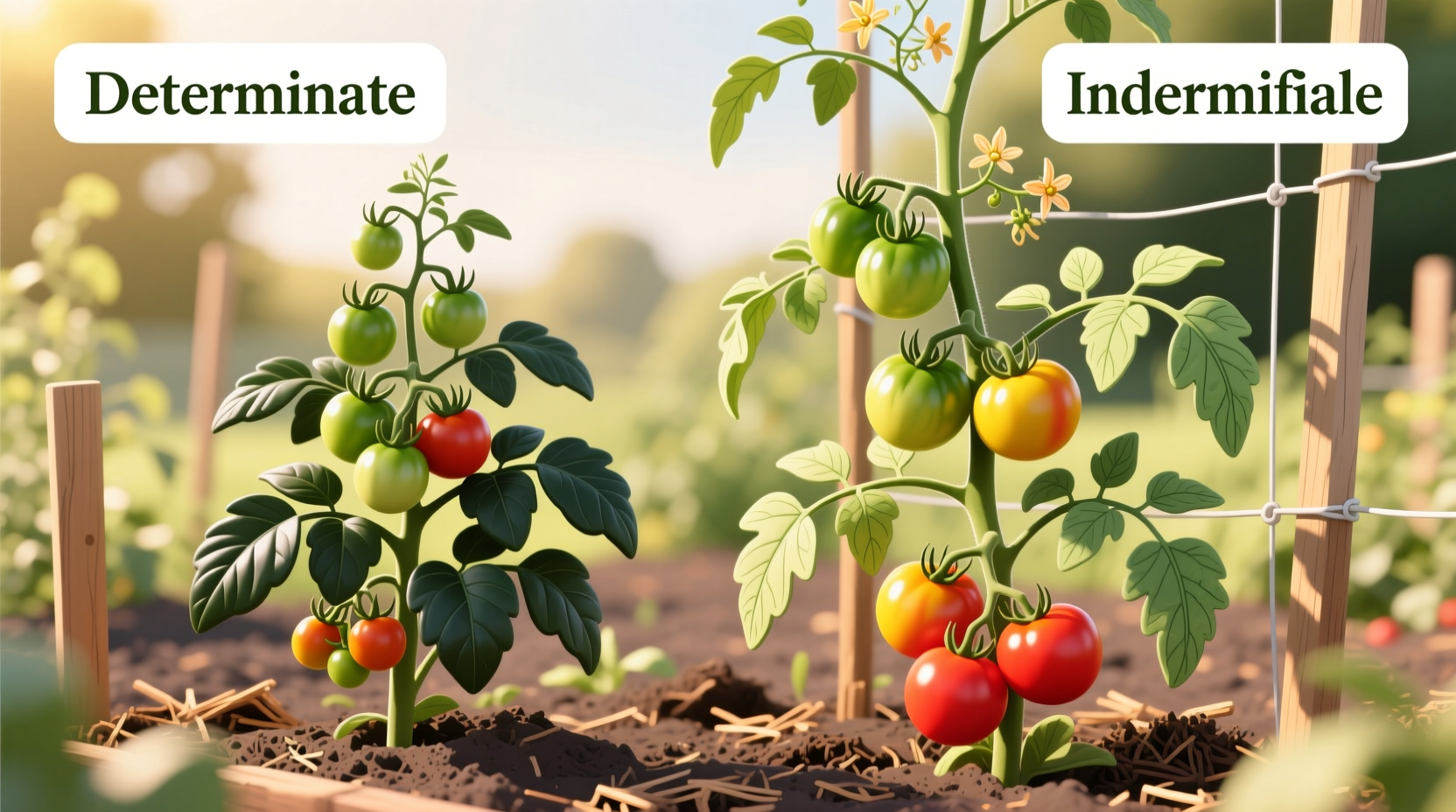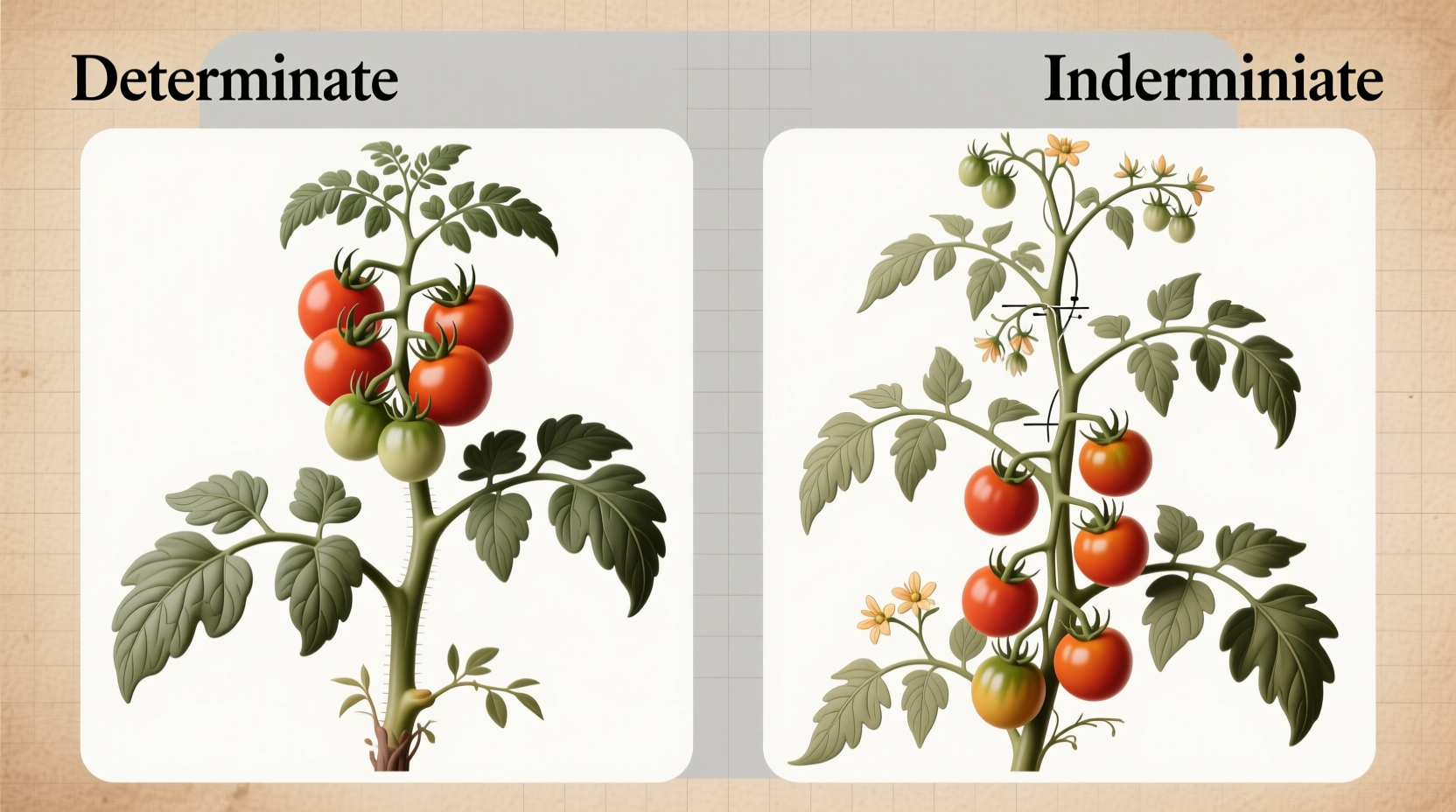Determinate tomatoes grow to a fixed height and produce all their fruit within a concentrated period (typically 2-3 weeks), making them ideal for container gardening and canning. Indeterminate tomatoes continue growing and producing fruit throughout the season until killed by frost, requiring staking but providing a continuous harvest for fresh eating.
Why Understanding Tomato Types Transforms Your Garden Success
Choosing between determinate and indeterminate tomato varieties isn't just a technical detail—it's the foundation of your entire growing strategy. Get this decision right, and you'll enjoy perfectly timed harvests that match your cooking needs. Choose poorly, and you might end up with overflowing baskets of tomatoes all at once when you only wanted a few for salads, or struggling with unruly vines that take over your entire garden. Let's break down exactly what you need to know to make the perfect choice for your specific gardening goals.
Decoding Determinate Tomatoes: The Compact Powerhouses
Determinate tomatoes, often called "bush" varieties, follow a predictable growth pattern that makes them exceptionally garden-friendly for specific situations. These plants reach a genetically predetermined height—usually between 3-4 feet—then stop vertical growth and focus energy on ripening their fruit.
Key characteristics that make determinate varieties valuable:
- Limited vertical growth—ideal for small-space gardening
- Synchronized fruit production—80% of harvest comes within a 2-3 week window
- Natural self-topping—no pruning required for most varieties
- Concentrated harvest—perfect for canning, sauces, or preserving
Gardeners consistently report higher success rates with determinate varieties when growing in containers or raised beds with limited space. According to research from the University of California Cooperative Extension, determinate types show 25% better adaptation to container environments compared to indeterminate varieties due to their smaller root systems and controlled growth habit.
Understanding Indeterminate Tomatoes: The Continuous Producers
Indeterminate tomatoes represent the classic vining tomato plant that keeps growing until frost. These varieties don't have a predetermined height limit and will continue producing new flowers and fruit as long as conditions remain favorable.
Essential traits of indeterminate varieties:
- Unlimited vertical growth—can reach 6-12 feet or more in a single season
- Continuous fruit production—harvest extends over 2-3 months
- Requires substantial support—needs staking, caging, or trellising
- Higher total yield—produces more fruit per plant over the entire season
Professional growers at the Cornell University School of Integrative Plant Science note that indeterminate varieties typically produce 30-40% more total fruit weight per plant compared to determinate types, but require approximately 50% more maintenance through pruning and support management.
| Characteristic | Determinate Tomatoes | Indeterminate Tomatoes |
|---|---|---|
| Growth Habit | Compact bush, stops growing at 3-4 feet | Vining, continues growing to 6-12+ feet |
| Harvest Period | Concentrated (2-3 weeks) | Continuous (2-3 months) |
| Support Needs | Minimal (small cages) | Essential (staking/trellising) |
| Ideal For | Containers, canning, small spaces | Continuous fresh eating, larger gardens |
| Pruning Requirements | Not necessary | Regular pruning recommended |
| Common Varieties | Roma, Celebrity, Bush Early Girl | Beefsteak, Cherokee Purple, San Marzano |
How to Identify Your Tomato Type Before Planting
When selecting seeds or seedlings, look for specific clues that indicate whether a variety is determinate or indeterminate:
- Seed packet terminology—"bush," "compact," or "determinate" indicates limited growth
- Days to maturity—determinate varieties often list "days to maturity" while indeterminates may say "continuous harvest"
- Plant descriptions—phrases like "perfect for containers" suggest determinate types
- Variety names—"Roma," "Celebrity," and "Bush" varieties are typically determinate
Once plants are growing, you can identify determinate varieties by their compact growth pattern and the formation of a terminal flower cluster at the top of the main stem. Indeterminate plants will continue producing new leaf clusters and flower sets without stopping.

Choosing the Right Type for Your Specific Gardening Goals
The best tomato variety depends entirely on your personal gardening objectives. Consider these scenarios:
When Determinate Tomatoes Are Your Best Choice
- You're growing in containers on a balcony or patio
- You want to can or preserve large quantities at once
- Your garden space is limited (small yards, raised beds)
- You prefer low-maintenance plants with minimal pruning
- You live in an area with a short growing season
When Indeterminate Tomatoes Make More Sense
- You want fresh tomatoes for salads throughout summer
- You have ample garden space for sprawling plants
- You don't mind regular pruning and plant maintenance
- You're growing in a greenhouse with extended season
- You prioritize maximum total yield over convenience
According to the USDA's National Institute of Food and Agriculture, gardeners who match their tomato variety to their specific growing conditions and culinary needs report 40% higher satisfaction with their harvest outcomes compared to those who choose varieties without considering these factors.
Planting and Care Requirements: Key Differences You Must Know
Each type requires specific planting techniques and care routines to maximize your harvest:
Determinate Tomato Care Guide
- Spacing: Plant 24-36 inches apart (closer than indeterminates)
- Support: Use compact cages (18-24 inch diameter)
- Fertilizing: Apply balanced fertilizer at planting; avoid excessive nitrogen
- Watering: Consistent moisture critical during fruit set period
- Pruning: Generally not recommended (removes potential fruiting sites)
Indeterminate Tomato Care Guide
- Spacing: Plant 36-48 inches apart with 4-5 feet between rows
- Support: Install sturdy stakes or trellises at planting time
- Fertilizing: Regular feeding every 3-4 weeks throughout season
- Watering: Deep, consistent watering to support continuous growth
- Pruning: Remove suckers to direct energy to main stems and fruit
The University of Florida's Institute of Food and Agricultural Sciences emphasizes that improper support for indeterminate varieties is the single most common mistake home gardeners make, leading to 30-50% reduced yields and increased disease problems.
Harvest Expectations: Planning Your Garden Timeline
Understanding the harvest patterns of each type helps you plan your gardening year effectively:
Determinate Harvest Timeline
- First harvest: Approximately 60-70 days after transplanting
- Peak production: 2-3 week window after first harvest
- End of production: Plants decline rapidly after main harvest
- Best use: Ideal for making sauces, canning, or freezing large batches
Indeterminate Harvest Timeline
- First harvest: Approximately 70-80 days after transplanting
- Peak production: Continuous harvest throughout summer
- End of production: Continues until first frost
- Best use: Perfect for daily fresh eating, salads, and sandwiches
Gardeners who understand these harvest patterns can strategically plant both types to extend their fresh tomato season. Start with determinate varieties for early concentrated harvest, then rely on indeterminate plants for continuous production through summer.
Troubleshooting Common Problems by Type
Each tomato type faces specific challenges that require tailored solutions:
Determinate-Specific Issues
- Blossom end rot: More common due to concentrated fruit set—maintain consistent soil moisture
- Overproduction stress: Plants may collapse after main harvest—provide extra calcium before fruiting
- Limited season extension: Cannot recover from late-season damage—choose disease-resistant varieties
Indeterminate-Specific Issues
- Verticillium wilt: More prevalent in long-season plants—rotate crops annually
- Pruning mistakes: Over-pruning reduces yield—remove only suckers below first fruit cluster
- End-of-season green tomatoes: Frost may catch unripe fruit—learn ripening techniques for green tomatoes
Research from the American Phytopathological Society shows that matching disease prevention strategies to tomato growth habit reduces crop loss by up to 35% compared to generic approaches.
Maximizing Your Tomato Success: Expert Recommendations
Seasoned gardeners and horticulture experts recommend these evidence-based strategies:
- For small-space gardeners: Grow 2-3 determinate varieties in containers plus 1 indeterminate variety trained vertically
- For canning enthusiasts: Plant multiple determinate varieties with staggered maturity dates for extended processing window
- For continuous fresh eating: Focus on 3-4 indeterminate varieties with different flavor profiles
- For short-season climates: Start with early-maturing determinate varieties, then follow with indeterminate types
- Always read variety descriptions carefully—some "semi-determinate" types offer hybrid characteristics
Remember that soil health, proper watering, and sunlight remain critical factors regardless of variety type. The Agricultural Research Service confirms that optimal soil conditions can increase tomato yields by 20-30% across all varieties.
Frequently Asked Questions
How can I tell if my tomato plant is determinate or indeterminate once it's growing?
Examine the stem growth pattern. Determinate varieties develop a terminal flower cluster at the top of the main stem, stopping vertical growth. Indeterminate plants continue producing new leaf clusters and flower sets without stopping. Determinate plants also tend to be more compact with leaves closer together, while indeterminate varieties have longer spaces between leaf clusters and continue growing upward indefinitely.
Can I grow determinate tomatoes in containers?
Yes, determinate tomatoes are excellent for container gardening. Their compact growth habit (typically 3-4 feet tall) makes them well-suited for pots. Use containers of at least 5 gallons capacity with good drainage. Fill with high-quality potting mix (not garden soil), and place in a location receiving 6-8 hours of direct sunlight daily. Water consistently as container plants dry out faster than garden-planted tomatoes.
Do indeterminate tomatoes require pruning?
Yes, proper pruning significantly improves indeterminate tomato production. Remove suckers (side shoots that form in leaf axils) to direct the plant's energy toward fruit production rather than excessive foliage. Focus on maintaining 1-2 main stems. Prune when suckers are small (2-4 inches) for clean removal with minimal damage. Avoid removing more than 1/3 of the plant at once to prevent sunscald on ripening fruit.
Which type produces more tomatoes overall?
Indeterminate varieties typically produce 30-40% more total fruit per plant over the entire growing season. However, determinate varieties produce their entire crop within a concentrated 2-3 week period, which can feel like more at harvest time. If you're counting total pounds of tomatoes over the entire season, indeterminate types generally win, but determinate types deliver their harvest all at once, which is preferable for canning or preserving.
Can I grow both determinate and indeterminate tomatoes in the same garden?
Absolutely, and many experienced gardeners recommend this approach. Plant determinate varieties along the front edge of your garden for easy access to their concentrated harvest, and place indeterminate varieties toward the back where they can grow vertically without shading other plants. This strategy gives you both an early concentrated harvest for canning and a continuous supply of fresh tomatoes throughout the season.











 浙公网安备
33010002000092号
浙公网安备
33010002000092号 浙B2-20120091-4
浙B2-20120091-4